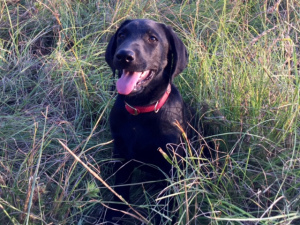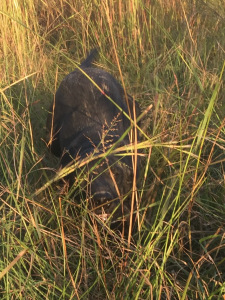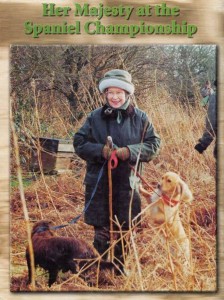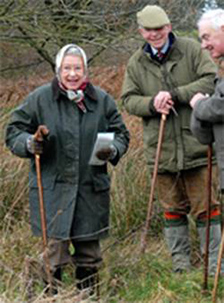Man-Up

As I approached the small, black lab puppy projecting volumes of pent-up energy while securely placed on tie-out, I immediately noticed his bright eyes of anticipation peering through a dusty face. Nash Buckingham, as this 13-week old Wildrose pup has come to be fittingly called, knows the routine. My approach means we are off for a lesson. This time, though, things are about to change for the little guy. The difference will not be the usually brief sessions involving sit, stay, place and a short retrieve, rather we are about to embark on the important steps of confidence building, independent thinking, decision making and de-sensitization experiences, all afileld, all in new and very different environments.
This part of puppy development is fun stuff. As followers of The Wildrose Way understand, there are three levels of puppy early development:
0-8 weeks – Super Learner/Super Scent
2-3.5 months – Backgrounding, the Essentials
3.5 -7 months – Early Starts
The first 16 weeks of a pup’s life are developmentally crucial. At these ages one can imprint so many valuable behaviors and exposures that will endure a lifetime. Obviously, make them good ones because what you put into a pup will likely become entrenched and will be around for a long time.
Nash is at the perfect age for first exposures to field challenges. Really, it’s all about “bolding” the youngster. He can now begin to comprehend new and different experiences yet still young enough for the lessons learned to become entrenched in his memory. Maximum care must be taken to ensure these “man-up” activities are positive with no chance of fear factors arising.
What to Avoid?
- Extremely cold weather
- High impact jumping or falls
- Gunfire
- Large dead or excessively bloody birds
- Close-up encounters with live game birds
- Larger, extremely aggressive/active dogs that could injure or intimidate
What we want is positive field exposures for the pup to independently (off lead) explore while still young enough to be somewhat dependent, preferring to stay close to me. Examples:
- Tall grass fields
- Shallow, warm water
- Small logs to cross
- Ditches to negotiate
- Leafy woodlands
 Nash’s lead was attached and we made our way to the tall, sage grass fields of the Wildrose training grounds at Oxford. No open field romps now. Rather, I want him a bit lost in the dense cover of high grass so he remains with me rather than on an independent frolic in an open field, so our off-lead walk a begins. Nash is free to explore. Still young and in unfamiliar surroundings, he doesn’t range far. Slowly, confidence is gained. Occasionally, I squat down low and recall (come) Nash using whistle and hand clapping. Without hesitation he responds receiving much praise when he reports in. Then he is released and the walk continues. The first field selected was tall sage grass then we made our way into a strip of milo. The thick foliage soon proved challenging.
Nash’s lead was attached and we made our way to the tall, sage grass fields of the Wildrose training grounds at Oxford. No open field romps now. Rather, I want him a bit lost in the dense cover of high grass so he remains with me rather than on an independent frolic in an open field, so our off-lead walk a begins. Nash is free to explore. Still young and in unfamiliar surroundings, he doesn’t range far. Slowly, confidence is gained. Occasionally, I squat down low and recall (come) Nash using whistle and hand clapping. Without hesitation he responds receiving much praise when he reports in. Then he is released and the walk continues. The first field selected was tall sage grass then we made our way into a strip of milo. The thick foliage soon proved challenging.
Nash lost his bearing. I walked a bit further and exited the thick milo, then knelt using the whistle recall and provided verbal encouragement. Shortly, the milo tops began to rattle signaling Nash’s progression toward me. When his exit was finally accomplished, of course, a big party had to occur in recognition of his courage and persistence. We keep our little outings short to make sure his young mind stays engaged and attention focused.
Day II – Exploration was broadened to include wandering woodlands, crossing back and forth over small logs and negotiating a small ditch. Only two recalls are conducted per outing to avoid boredom. Future de-scent and confidence “man-up” exposures will include:
- Rides on an ATV
- Bounding about in thick pond mud (fun)
- Wading in shallow water (removes the fun)
- Exploring shallow water covered with lily pads
- Place training is moved to realistic field locations:
- Boat stands
- Duck blinds
- Tree stands
- Water platforms
Place is place no matter the location. No stimuli like thrown denials or honoring other working dogs at this point, just place reinforcement expecting still, quiet, patient behaviors.
Our confidence walks are accomplished alone, no other dogs to misdirect Nash’s focus and attention as we explore a strange, new world for him. Soon the opportunity will be lost. Nash will enter an age of independence and become less susceptible to the powers of imprinting. For now, his eyes of enthusiasm and expression of curiosity tell it all. He is becoming bolder every day: confident, decisive and, of course, fun!
Article: https://wildroseblog.wordpress.com/



